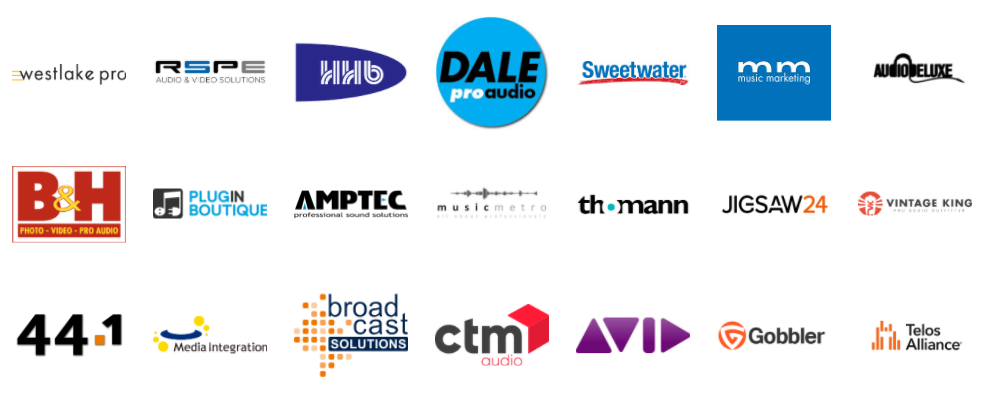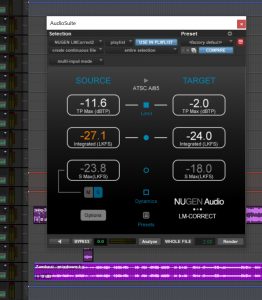How to Go from Spending Hours Hitting Loudness Targets to Doing it Instantly Using Linear Gain Correction
Join 5000+ other audio-post users including...


Nick Fry
Senior Dubbing Mixer, The Farm
“Since time is obviously of the essence after the mixing process, LM-Correct offers faster-than-real-time and intuitive corrections and an automatic method of rapidly conforming the audio to the loudness standards”

Cheryl Ottenritter
Creative Director/Senior Mixer, Ott House Audio
“I found the beta version of LM-Correct, NUGEN Audio’s loudness analysis and correction software. I watched for the full product to be released and have been using it... at OHA ever since”

Korey Pereira
Owner/Director, Soularity Sound
“I ... want to make sure they have a version of the mix that meets broadcast standards. I’ll do a really subtle theatrical mix that I can start off on, then I’ll use NUGEN’s LM-Correct to create a broadcast and web version.”

Daniel Jones
Managing Director, Vaudeville Post
"To help us stay on spec, we’ve been using ... the LM-Correct loudness measurement and correction tool in all of our studios since 2011… It quickly became a vital tool for us”

Lucy Mitchell
Sound Editor and Dubbing Mixer
“A lot of my recent projects have been short form, which means multiple versions and quick turnarounds. I love using LM-Correct for this”

Emma Butt
Dubbing/Re-Recording Mixer, Sound Editor and ADR Recordist
“For short form content, LM-Correct is also handy to have around. The timescale for those jobs can be incredibly tight, so I need to get my mix up to spec as quickly as possible, especially if I've got a client asking for stems immediately.”
TV audio projects have increasingly tighter deadlines and more complex delivery specifications for the same or less budget. The pressure is on the post engineer to deliver a fantastic sounding mix, that also meets the spec, in less time.
If you want to work on award winning Netflix shows (or Disney, Amazon Prime, HBO, BBC, etc) you need to know how to deliver exceptional sound quality, meeting the delivery spec. If you want to get regular work on those projects you need to know how to deliver to spec, at speed, without breaking a sweat.
If you want to get back more time to focus on quality, and spend less time hitting a target number, or you suspect that there’s an easier way to meet your delivery specification’s loudness targets, or if you hate getting submitted mixes rejected, then you have come to the right place.
You can deliver your TV audio mix according to the client’s delivery specification by playing your final mix-down through a broadcast loudness meter and going back into the mix to adjust levels, scene by scene, and repeatedly measuring again until you are on target.
However, doing this in real-time, by hand, wastes precious time and is error-prone. This is especially inefficient at the end of a project, or when you have to provide multiple deliverables.
We have solved this problem simply and instantly.
We were founded in 2004 in the UK and have been developing software tools to work with Broadcast Loudness standards since 2010. As a doctor of pure mathematics, I know how important it is to get the numbers right, and my many years of experience as a lead software engineer mean I know that, at the end of a complex project, involving multiple stakeholders, you end up with the last engineer in the production chain having tremendous pressure put on them to deliver the final product.
Our loudness software is used by broadcasters, and video streamers, around the world - including Netflix, Disney, Amazon Prime, HBO, BBC, ITV, NHK, etc. Our loudness tools are used by thousands of Post-production engineers to measure and hit loudness targets, and also used by QA departments to check loudness compliance of submitted mixes.
We developed our first loudness meter in 2010. Speaking to customers, they loved the clear accurate display of loudness levels but explained about the difficulty of delivering a mix exactly to spec at the end of the project, and the time that this wasted. We felt sure that it must be possible to make software to help with this task.
The resulting tool and massively improved workflow was better than we’d hoped and revolutionised that task at the end of each project.
Some of our dealers include...

How To Hit The Loudness Target
TV audio delivery specifications now-a-days include target loudness levels. Failure to get close enough to the target overall loudness level can result in a submission rejection, costly re-work, missed deadlines, and damaged reputation. Different broadcasters specify different loudness targets, and even different standards to use when measuring the loudness.
OLD WAY
To meet the loudness requirements, you can work on balancing your mix until you are happy with it. Then print your mix and play it through a broadcast loudness meter set to the correct loudness standard according to your delivery spec. Compare your measurement against the target level and if you are too far away, go back and adjust the levels in some of your scenes hoping that this will bring your overall measurement closer to the target. Remeasure the whole mix and repeat the process until you are within the tolerance of your delivery spec.
OLD RESULT
This is time consuming which is expensive and frustrating. It happens at the end of the project, when you are under the most pressure and already fatigued, which can lead to mistakes. It can be a confusing process as louder scenes are weighted more heavily in the overall loudness measurement than quieter scenes, and just adding more silence, or very quiet portions, won’t change the measurement at all.
Also, this method means taking a mix that you were happy with the sound of and rebalancing scenes just to hit an overall measurement number, which feels arbitrary and counter-productive.
NEW WAY
But - there is a better way. You can work on balancing your mix until you are happy with it. You should primarily be using your ears, but you might also find it helpful to have a real-time loudness meter running on your master-bus for you to glance at every now and then for orientation (we make a great real-time loudness meter for this).
Once you have the mix that you like the sound of you can measure its overall loudness, calculate the offset from the target loudness and then apply its inverse as a linear gain to the whole mix, to deliver the mix, with exactly the same balance between scenes, but now exactly on target for loudness.
To comply with the maximum “True-Peak” level required (which will also be part of the delivery spec), you could also place a transparent limiter, which works with the True-Peak standard, on the master-bus after your linear gain, to ensure you don’t have any overs.
This would all be even better if you could run it faster than real-time, and have the gain control automatically work out the correct level to hit the target for you.
NEW RESULT
This better way of hitting the loudness target will result in huge time savings as it avoids having to play your mixdown through a loudness meter and also the iterative correction phase. It will also result in a mix which is exactly on target, without having had any arbitrary last-minute adjustments made to its balance, and without the risk of errors caused by last minute time-pressure or fatigue.
You can even use this same simple process to quickly deliver alternative versions of the mix for different loudness targets.
So, all you need to do is mix with your ears, and when you’re happy that you have a great mix, take an overall loudness measurement, and then apply a linear gain of the offset from your loudness reading to the target on your master bus, followed by a True-Peak limiter.
This will give you your great mix, perfectly on target for loudness.
Now - you could achieve the same result by manually running your mixdown through a loudness meter, then calculating the offset, dialing it into a gain control on your master-bus, and mixing-down again, with a True-Peak limiter at the end of the chain.
This would take at least as long as the length of your program (to run it through the meter), and rely on you getting the offset correct at the end of a long mix session when you just really need to send off the mix and go home to bed.
Or - you could use NUGEN Audio’s Loudness correction tool, LM-Correct.
Again, this is for audio post-production engineers who need to deliver TV audio mixes, hitting a loudness target in the delivery spec, but who don’t have hours to waste at the end of the project trying to hit the spec.
Here’s what’s going to happen when you start using LM-Correct to deliver your mix:
- You will deliver exactly to loudness spec every time
- This includes catching and correcting any True-Peak overs
- You can save time and stress at the end of the project
- You can put more time into getting an incredible audio mix
- You can forget about getting QA rejections
- You will confident and calm as you submit your final mix because you know it’s exactly right for Loudness
- You can create repurposed mixes for different delivery specs with ease
So, how does it work?
Before, when you wanted to hit your Loudness Target, you would have to measure your mix for Loudness and iteratively tweak the levels until you got close enough to the target. But, now you can use this simple audio plug-in to exactly hit the target without wasting hours and having to rebalance your mix.

Before, when you wanted to remix alternative versions of your mix you would have to again rebalance iteratively to hit the different Loudness Targets for the different deliverables. But, now you can just select the preset for the correct delivery spec and instantly create the new deliverable. Saving you more precious time and giving you peace of mind.
Now, if you wanted to get this job done before using manual measurement and rebalancing, for a 1 hour episode, it would have taken you at least 2.5 hours - probably longer.
How much is 2.5 hours back per project worth to you?
You also have the peace of mind that your mix will not be rejected for not hitting the Loudness Target.
How much would a rejection cost you in the time to remix it? How much would it cost in terms of reputation?
Instead of this, we are offering you the tool that solves these problems, LM-Correct, for only $399. How many projects would it take for that to be saving you money time after time?
All you need to do is sign up with the button below to get access to the free demo to try it out for yourself and see how much time and trouble you can save.
Can you afford to take risks with the Loudness delivery of your current project?
Make sure you start using LM-Correct now to avoid missing out on the time-savings and peace of mind.
How fast is it?
This, of course, depends on your processor and disc speed, but typically you’d expect the process to be something like 60x real-time. So, for a 1 hour documentary, instead of playing the full mix through a real-time loudness meter (1 hour), adjusting some levels in the mix (30 mins), measuring again (1 hour) = 2.5 hours (assuming it was close enough second time around), the whole process could take just 1 minute. That’s a 99.3% time saving on this task!
Does it work outside of ProTools?
Yes. LM-Correct works as an AAX AudioSuite plug-in within ProTools and Avid Media Composer. Within Adobe Premiere it works as a CEP Panel. For other DAWs / NLEs, you can use LM-Correct as a stand-alone application (Mac or PC) and apply the process to your final mixdown .wav file.
Does it work in surround?
Yes. LM-Correct works up to 7.1.2.
Does it measure dialog for Netflix delivery?
Yes. LM-Correct uses the Dolby dialog detection algorithm to measure dialog loudness, allowing you to deliver according to the Netflix delivery spec.
Do you need to be an audio expert to use it?
No. LM-Correct is specifically designed to be very easy to use. It is frequently used by video mixers to ensure their audio is loudness compliant.